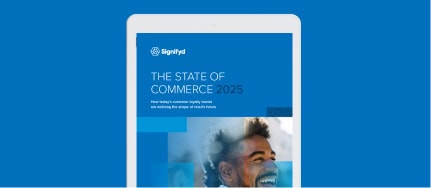Is anything more insulting — and later, maddening — to online shoppers than when their order is declined for no apparent reason?
The only upside is that they didn’t have to stand at a checkout counter with a line of impatient shoppers waiting behind them. Now, that would be pure embarrassment.
False declines happen when a merchant mistakenly flags an online payment as fraudulent and declines it. And it’s not a rarity – 20% of respondents reported having experienced a false decline, according to a Talker Research survey commissioned by Signifyd.
With false declines, nobody wins: In the same poll, 35% of respondents told Talker they would either give up on buying an item or turn to another retailer if they were subject to a false decline.
An analysis of Signifyd data found that 27% of consumers who experience a false decline don’t come back to shop with that retailer again. Those who do return, spend considerably less after the bad experience — 17% less in 2024 and 24% less in 2023.
False declines cost retailers dearly
For ecommerce merchants, in addition to the expense of possibly losing a customer and the cost spent to acquire the customer, false declines cost merchants $16.3 billion a year, according to a 2021 study by 451 Research..
When a shopping moment gets ruined by a false decline, the culprit is generally the overly strict fraud detection rules and/or outdated legacy systems that ecommerce merchants depend on for fraud protection. By partnering with a fraud protection company that employs advanced AI technologies, merchants can relax a little.
“Our previous partner was impacting our operations because they were blocking transactions when they were genuine, said Sofia Giussani, director of digital marketing for BHFO, an online retailer of designer clothing, accessories and shoes.
BHFO deployed Signifyd’s Complete Chargeback Protection, which allowed them to dramatically reduce fraud and unnecessary customer friction in the shopping process. The result: BHFO’s approval rate increased to 99.66% and its chargeback rate declined by 69%.
False declines victims crush retailers on social media
With first-time customers, merchants are especially cautious when approving purchases since they’ve never seen them on their sites before. And their fear of fraud is understandable: Global ecommerce fraud losses are predicted to grow from $44.3 billion in 2024 to $107 billion in 2029, an increase of 141%, according to Juniper Research.
Yet all those numbers mean little to a shopper when their purchase has been rejected unfairly. On Reddit, where communities air grievances about most everything, it’s clear from posts that the most aggravating part of a false decline is not knowing why an order was declined, which sends shoppers scrambling to find the reason they’ve been rejected. Yes, shoppers take this very personally.
One Reddit shopper was merely trying to buy a 48-inch workbench online because, though he usually shops in-store, it wouldn’t fit in his car. But no matter what he did – checked out as a guest, manually entered information, used different computers – his card wouldn’t go through.
In another post, a shopper was trying to buy from the same merchant and used four different cards. Each time the purchase was apparently approved by the bank, only to have the merchant reverse the charge almost immediately: “Pretty infuriating on the last night of current sales.”
Online merchants sometimes don’t provide phone numbers, only email addresses and chat, which might not be staffed 24 hours a day. Unless you hit the timing right, there’s no immediate way to reach the merchant, and that’s upsetting. So shoppers call their bank seeking an explanation. The good news is that even at night, someone at a bank answers the phone. Well, sometimes.
Balancing an improved ecommerce customer experience with preventing fraud
Around 60% of businesses estimate that their false decline rate falls between 1.1% and 5%, according to ThetaRay. That means with an annual revenue of $50 million, they will lose up to $2.5 million due to false positives.
So it’s a conundrum. Online retailers are trying desperately to meet the demands and gain the loyalty of shoppers by implementing innovative payment plans, launching social commerce platforms for a more personalized experience and adding tools to create safe and speedy checkouts. But combating fraud makes it a tough journey and a difficult balance for online merchants.
With ecommerce expected to continue to grow as a percentage of retail sales globally, U.S. merchants have said improving conversion rates with new technology is their top request of payment service providers (PSP), according to a recent report from PYMNTS.
AI-driven solutions can help improve ecommerece customer experience
Innovating with AI-driven solutions, companies such as Signifyd have emerged to help online retailers with fraud technology that surpasses legacy, rules-based solutions. Signifyd’s Commerce Protection Platform helps ensure that transactions are legitimate allowing merchants to approve more orders.
On average, Signifyd ecommerce customers experience an approval rate increase of up to 8%.
“Ecommerce merchants must seek to integrate fraud prevention systems that offer AI capabilities to quickly identify emerging (fraud) tactics,” said Thomas Wilson of Juniper Research. “This will prove especially important in developed markets, where larger merchants are at higher risk of being targeted for fraud, such as testing stolen credit cards.”
How to improve ecommerce customer experience
Signifyd uses a consortium model on a global network, which allows it to recognize 98% of the shoppers who arrive for the first time on a retailer’s site. Its Commerce Protection Platform relies on transaction, behaviorial and historical data to understand the identity and intent behind each order. Along with that, its Guaranteed Fraud Protection and Complete Chargeback Protection leverage Signifyd’s Commerce Network to identify suspicious activity.
Even when working with a first-time shopper who’s hesitant to divulge information, such as when a customer prefers not to open an account, a merchant can protect itself and embrace the new customer if it has partnered with a commerce protection provider such as Signifyd, which instantaneously can sort fraudulent from legitimate orders.
Everything needs to work and be fast
Signfyd’s use of advanced technology helped increase one retailer’s revenue by $10 million. Hot Topic, an apparel retailer steeped in pop culture, is a multi-brand/multi-channel enterprise with a thriving ecommerce business.
By partnering with Signifyd, Hot Topic increased its approval rate to 99% and reduced its order approval times to an instant. The company mantra, says CEO and President Steve Vranes, is, “Everything needs to work and be fast.”
How Hot Topic improved more orders while improving its ecommerce customer experience
Hot Topic and Box Lunch CEO Steve Varnes talks about his company’s evolution from a physical retailer to an omnichannel merchant with a thriving ecommerce business and the role dramatically reducing false declines played in the organization’s success.
“Pre-Signifyd, approval could take hours and sometimes 24 hours,” Vranes said. “Signifyd’s chargeback guarantee took the liability out of the equation for us. So overall, the benefit from Signifyd has been a multi-million dollar benefit – it’s over $10 million in incremental revenue for us annually, and that doesn’t even capture the additional revenue that we’ll gain from customers that had a great experience and are going to come back and shop.”
Want to improve your customer experience and reduce false declines? Let’s talk.







